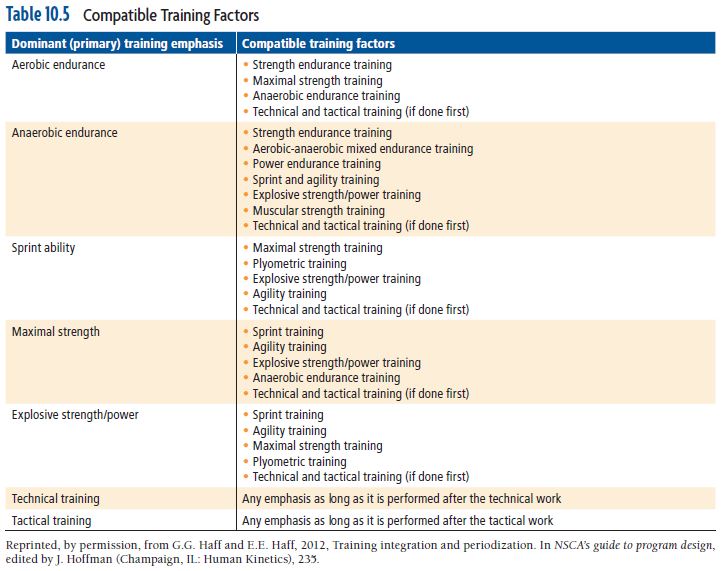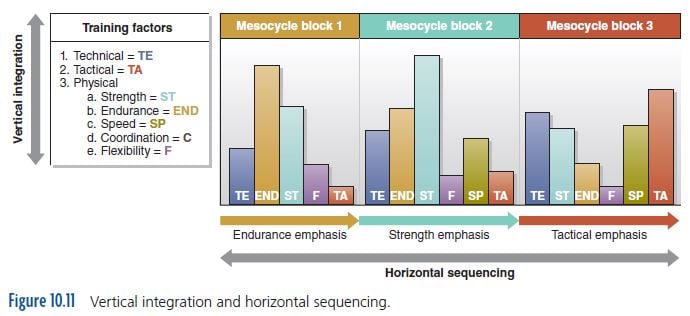Sequencing and Integrating Training
by NSCA's Essentials of Tactical Strength and Conditioning
Kinetic Select
December 2020
This article breaks down periodization into sequencing and integrating training factors to optimize training outcomes.
The following is an exclusive excerpt from the book NSCA's Essentials of Tactical Strength and Conditioning, published by Human Kinetics. All text and images provided by Human Kinetics.
A key aspect of periodization is sequencing and integrating training factors in order to direct training outcomes. Although this concept is not new (49), recent scientific evidence reveals the superiority of appropriately sequenced (51, 81) and integrated training programs (14, 24, 36) when compared with traditional training models. From a sequential standpoint, it is important to remember that the training residuals created in one mesocycle will directly influence the training outcomes of subsequent mesocycles. If, for example, the targeted outcome of a series of mesocycles is the development of muscular power, a horizontally sequenced series of mesocycles might proceed as follows (81):
Strength endurance → strength → power
In this traditional example, the strength endurance phase develops the fitness foundation from which strength can then be maximized. After the athlete’s maximal strength is increased, the ability to optimize power output with specific training interventions is maximized as a result of architectural changes and neuromuscular adaptations of the muscle (51, 81).
Though sequencing of training is a critical aspect of periodization, it is also important to consider how the individual training factors integrate. Appropriate integration of training factors allows for compatible factors (table 10.5) to be trained simultaneously without creating interference effects that mute or hinder the targeted performance gain (27-29). Vertical integration of training factors is important for tactical athletes, who may need to develop several training outcomes in preparation for their operational engagement. When the training plan is appropriately integrated and sequenced, the ability to manage workloads and enhance tactical performance is maximized.

A lack of sequencing and integration is most noted in training programs that address or emphasize all training factors at the same time (27-29) without consideration for how these factors interrelate. This lack of sequencing and integration creates the blender effect (27): excessive accumulated fatigue that makes it impossible to optimize performance at appropriate times (26, 78), increases the risk of overtraining (69), and increases the potential for injury (23). These effects are even greater for tactical athletes than sport athletes because failure to be prepared for operational engagements can have worse outcomes (i.e., extreme bodily harm or death).
Conversely, in a well-crafted periodized training program, the ability to determine when optimal performance occurs is greatly increased, overtraining potential is reduced, and injury potential is markedly reduced (27-29). The periodized training plan is able to accomplish these goals thanks to the vertical integration and horizontal sequencing of training factors. Vertical integration involves looking at how the various training factors interact within a specific mesocycle block, whereas horizontal sequencing deals with how the factors are sequenced.
Figure 10.11 presents an example of how several training factors can be vertically integrated or prioritized in accordance with their mesocycle block. Additionally, it presents a horizontal sequential pattern in which the targeted factors vary in their emphasis in each mesocycle block. For example, in block 1, the main emphasis is endurance development, with strength being the secondary emphasis and technique being a tertiary emphasis. In mesocycle block 2, strength becomes the primary emphasis and endurance becomes secondary. After completing block 2, tactical training is the primary emphasis and tactical employment of techniques is the secondary emphasis. So for these three mesocycles, the targeted emphasis progresses from endurance to strength and ends with tactical performance. Conceptually, vertical integration is a modulation of emphasis within a block, while horizontal sequencing is the sequential prioritization of specific training factors over time.

The success of the periodized training plan is largely influenced by the ordering of successive mesocycles in relationship to the mechanical specificity (5, 59), metabolic specificity (59, 71), and time course for the involution of residual training factors (39, 40). Additionally, how the training factors are vertically integrated will influence the success of the sequential model. For example, if the targeted outcome is maximal strength, then including large volumes of endurance work can result in interference effects that mute the ability to develop strength (27).
NSCA's Essentials of Tactical Strength and Conditioning is the ideal preparatory guide for those seeking Tactical Strength and Conditioning Facilitator® (TSAC-F®) certification, and a reference for fitness trainers who work with tactical populations such as military, law enforcement, and fire and rescue personnel. The book is available in bookstores everywhere, as well as online at the NSCA Store.
- Privacy Policy
- Your Privacy Choices
- Terms of Use
- Retraction and Correction Policy
- © 2025 National Strength and Conditioning Association